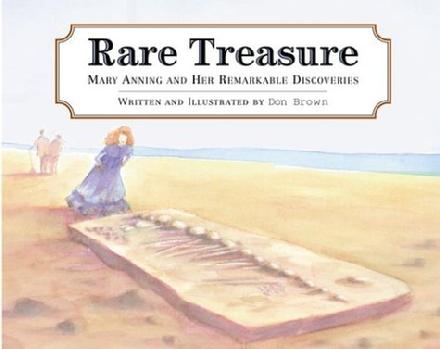 |
| Publisher: Houghton Mifflin |
|
Our Winning Book Synopsis:
This is the true story of a little girl, Mary Anning, who grew up in small, seaside town in England in the early 1800s. Mary's childhood hobby of hunting and collecting fossils that she found on the beach near her home eventually led her to become the world's first woman paleontologist (fossil scientist).
On her illustrative journey from little girl to grown woman, she overcame many obstacles, learned a great deal about fossilized organisms, made some important scientific discoveries, earned a living by selling the fossils she found, and eventually became an world authority on marine fossils.
Her father had introduced her to fossil hunting as a little girl, and, later, her friend Henry de la Beche helped her to gain recognition for her work within the then predominantly male scientific community, but it was Mary's own scientific curiosity, determination, and talent that was responsible for her success and happiness.
The book's author, Don Brown, traveled to the UK to visit the leading authority on Mary Anning--Professor Hugh Torrens--to make sure his book would be accurate. He also consulted with experts at the British Museum of Natural History and the Dorset County Library to gain additional insights about Mary's life (1799-1847) and her work. We were impressed by such devotion to scholarship and detail. It helped Don Brown to write a text that teaches basic paleontological principles in such a simple and seamless way that you think you are merely reading an engaging children's story--which, of course, you are! Mary's story is carefully crafted to deviate from the wooden, factual accounts that characterize most children's science books and it is punctuated by scary episodes that serve to vary the tempo and the pitch of the story--making us worry about Mary's predicaments and about what will happen next!
The book's illustrator--again, Don Brown--has produced a book of soft and enchanting beauty, using an earth-toned palette with pen & ink and watercolor vignettes. His visual rhythms of sparse, and mood-evoking images--sometimes diffuse, environmental, and spacious, othertimes focused, detailed, and child-centered, invite repeated viewings, and the accompanying text, re-readings.
Such subsequent readings and viewings are rewarded by children's surprises such as the sudden notice of a dark, murky sea turtle swimming beneath the waves. The illustrator also uses a clever time-series drawing that illustrates the fossilization of a dinosaur. We see lightning that looks (and sounds!) so real we want to run from it. Details like Mary's sand-stained dress, and strong-armed Mary reading a heavy science book while holding a weighty fossil, enhance our experience. Brown cleverly uses Mary's faithful "fossil dog" standing watch next to a huge fossil to add scale to the illustration. We are amazed at Mary's great strength as she hoists a teenager from the sea. We snicker as we see an unappreciative little girl trying to AVOID looking at one of Mary's great fossil finds (mounted on a museum wall) while--in dramatic contrast--her brother strains to see it. We will always remember Brown's child's-eye view of the crowded interior of Mary's fossil shop, and of an older and contented Mary fading into the mist at the end of her illustrious career--her dog quietly sniffing the sand for yet another a new fossil.
Will little girls be inspired to consider careers in science by this book? Perhaps. Mary helped to make such dreams attainable. Will little boys learn about the exciting science of paleontology from this book? Perhaps. Mary's brother Joseph helped her make a major fossil discovery. Will parents realize that a little nature walk and an impromptu lesson taught to a child on a beach might actually set the course for a lifetime pursuit? We hope so. Alas, Mary's father, Richard, didn't; sadly he died before Mary's career choice became evident. Will reading the text and visualizing the scenes in Don Brown's book ignite or rekindle its reader's interest in observing the living world directly? We think so. We challenge you to read this book and yet remain indoors--resisting the natural world's beckoning to explore it. You will soon find yourself walking on a beach--a young Mary Anning or Joseph Anning at your side--looking for shells or aquatic life or plant and animal fossils. Who can predict what will happen next!
|